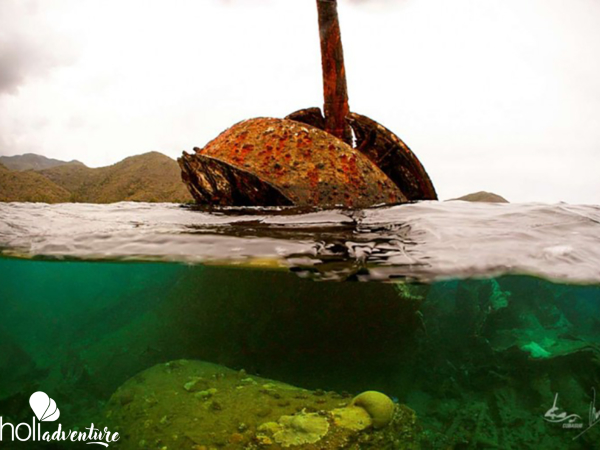General Information
- Category: Half day tours
- Modality: Nautical tours
- Duration: 2.00 hrs
- Departure time: 9:00 hrs
- Tour guide: Yes
- Children are allowed: No
- Languages spoken: Spanish and English
- Location: Marina Marlin Punta Gorda. 1ra., Santiago de Cuba, Cuba. Tel: (+53 22) 69 1446.
Program Details
Diving in wrecks from the Spanish-Cuban and American War of 1898. **"ADMIRAL OQUENDO BATTLESHIP".
Archaeological Park of the Natural and Cultural Underwater Heritage, Naval Battle of Santiago de Cuba Declared a National Monument in 2015.
General description
Seven archaeological sites (Playa Siboney, Las Cuatro Bocas, Mar Verde Beach, Rancho Cruz - Buey Cabón, Ensenada de Juan González, Aserradero and La Mula Beach). The environmental and archaeological conditions are different among them because of their location along the southeast coastal strip. It covers an area of about 64,824 nautical miles, equivalent to about 120,051 km along the coast from Siboney beach, belonging to the municipality of Santiago de Cuba, to the beach "La Mula", referring to the municipality of Guamá.
This area was the scene of one of the most important events in world history. This Naval Battle, which ended with the sinking of the fleet of Vice Admiral Pascual Cervera y Topete, represented the end for the Spanish colonial rule in America and gave way to the rise of the United States of America empire.
The vestiges of that confrontation, represent what today is known as the Underwater Archaeological Park "Batalla Naval de Santiago de Cuba". This Park is made up of seven archaeological sites where the wrecks that participated in the naval conflict are found, as well as material evidence of the ships that are related to the events, for example: masts, masts, remains of the rigging of the mastheads, ironwork, parts of the artillery sites, thick and medium caliber projectiles, flushes, balusters and mechanisms of the propulsion system. On the other hand, due to more than a century of rest and biological activity, this ecosystem is special where sessile fauna and marine flora have merged with the wrecks into a symbiotic entity that protects them mutually.
For many years these sites have been of special attraction for researchers, archaeologists, divers and tourists in general, justified not only by the transcendental historical value of the famous Battle of the Sea, but because it is a real privilege to enjoy today the dives in these wrecks located in an environment of spectacular beauty, in which the Sierra Maestra mountain range bursts into the Caribbean in an abrupt and irregular manner, cut by canyons and riverbeds and estuaries that extend into pebble-covered deltas and low-lying areas, forming mangrove-covered wetlands under the shelter of virgin inlets and coves: ecosystems that support incredible biological diversity.
It is an enormous privilege to live history through these wrecks, witnesses of the Naval War of 1898, a treasure of the Underwater Cultural Heritage not only of Cuba but of the world.
ARCHAEOLOGICAL SITE: "JUAN GONZALEZ COVE". Wreck: Battleship Cruiser "Almirante Oquendo ".
- Place: Juan Gonzalez beach, west of Santiago de Cuba city.
- Municipality: Guamá.
- The Battleship Cruiser "Almirante Oquendo" is located in the Juan Gonzalez cove about 100 meters from the shore and at a depth between 4 and 13 meters. From the coast, part of the turret of a González Hontoria cannon, which emerges on the surface of the water, is visible.
Historical summary:
The battleship Almirante Oquendo is of Infanta María Teresa type construction, as is the Vizcaya. These ships, catalogued as first class protected cruisers, were also catalogued as armoured cruisers. Excellent in their design, but with a significant vulnerability in the superstructure, especially due to the secular delay of the Spanish naval industry at that time.
As part of Admiral Cervera's squadron, the Oquendo sailed to the Caribbean. During the battle of July 3 in Santiago, the Oquendo was the fourth ship to leave, being promptly damaged by the rapid artillery of the battleship USS Iowa BB-4. It took 43 hits from the Iowa's 57 mm guns, killing or wounding most of the sailors on the upper decks.
The Oquendo was also hit by the heaviest guns in the US fleet, including three 203 mm (8 inch) hits, one 152 mm (6 inch) hit, one 127 mm (5 inch) hit and 102 mm (4 inch) hits.
Their commander, Captain Lazaga, fatally wounded, flooded the storerooms. The cruiser sank at about 10:30 a.m. some 700 m (less than half a mile) from the Cuban shore, 12.6 km from Santiago. Some 80 men died in the battle.
TECHNICAL CHARACTERISTICS OF THE BOAT "Almirante Oquendo "
- Name of the wreck: "Admiral Oquendo".
- Class: "Infanta Maria Teresa".
- Type of vessel: 1st class battleship cruise.
- Flag: Spain.
- Date of commissioning: 16 November 1889.
- Shipyard: Sociedad Astilleros del Nervión, Sestao - Spain.
- Launch date: 3 October 1891.
- Commander: Captain Juan Bautista Lazaga y Garay.
- Crew members: 497 men.
- Length: 110.9 metres.
- Beam: 19.9 meters.
- Strut: 11.58 meters.
- Draft: 6.6 meters.
- Displacement: 6,890 tons.
- Maximum speed: 20.25 knots.
- Autonomy at low consumption: 9,700 miles (nautical).
- Type of bow: Lower half-bulb launch.
- Decks: Steel and wood.
- Rudder: Aft, spade outside the transom with shaft running to deck, driven by a servo motor.
- Shielding: Armored belt 305-254 mm.
- Shielding: Deck 76-52 mm.
- Barbets: 229 mm.
- Type of machinery: Triple vertical expansion steam engine.
- Type of feeding: Mineral coal - 1050 tons.
- Power : 13 700 CV.
- Boilers : 3 units.
- Propulsion : 2 propellers.
- Masts : 2 masts.
- Large caliber artillery: 2 "Hontoria" 280 mm guns in barbeque towers at bow and stern.
- Rapid fire artillery: 10 x 140 mm "Hontoria" guns. Behind mantelets (rapid fire) 8 Nordenfelt 57 mm guns (rapid fire).
- Medium calibre artillery: 2 "Hontoria" 70 mm simultaneously loaded guns Hotchkis 37 mm revolvers: 8 pieces.
- Maxims" machine guns: 2 pieces.
- Torpedo launchers: 8 tubes with 365 mm torpedo launchers.
Diving services included:
- Basic diving equipment,
- Compressed air tank.
- Leaded belt.
- Assistance of a guide instructor with international certificate, who will make an informative briefing of the immersion to be done.
- Boat that takes them from the diving center to the diving points (In principle the dives leaving from the Marina marlín Punta Gorda will be done by diving boat).
Punta Gorda Marlin Dive Center
- This Diving Center provides service to the hotels in the city of Santiago de Cuba.
- Capacity per departure: 10 Pax.
- Frequency: 2 daily departures.
Degree of difficulty: Medium.
Distance to be covered in the excursion (round trip): 30 kms approximately.
Approximate duration of the excursion: 2 - 3 hours approximately
Very important note: It is obligatory for the clients to present their official diving certificate.
Very important note: For safety and protection of the underwater heritage, customers may never directly touch the remains of sunken ships and must strictly comply with the instructions issued by the diving instructors.
TIPS: • Recommended: light clothing, swimsuit, towels, sunglasses, hat, sunscreen and photographic camera. • We recommend that the client can bring their own diving mask. • The client can bring his complete diving equipment if he wants to. • We recommend that the client can bring his/her personal dive computer. • We recommend that the client can bring one or more bottles of mineral water to stay hydrated as well as light foods rich in protein or fruit.
- The boat is shared.
- A minimum of 5 divers is required for the excursion. Holiadventure will reconfirm 48 hours before the departure of your tour. If the provider decides to cancel, for not meeting the minimum required amount of passengers, Holiadventure will offer an alternative tour or fully refund cost of your trip.
- Transportation not included in the services of the diving excursions in Santiago de Cuba. The client must arrive at the Marina Marlín in Punta Gorda by his own means 30 minutes before the indicated time of the excursion.
- The excursion can be cancelled in an unexpected way if the general weather conditions and especially in the sea advise it. This does not imply any responsibility or penalty for the agency and the marina company offering the service. In principle we will try to change the date of the excursion for the following days when the conditions improve. If this is not possible, we will proceed to refund the total value of the excursion paid by the client previously.
- The client must present a valid diving certificate issued by an internationally recognized diving organization.
- The client must sign a waiver of responsibility for diving as a risky activity, releasing the agency and the marine company offering the service from any legal responsibility, before leaving for the excursion.













